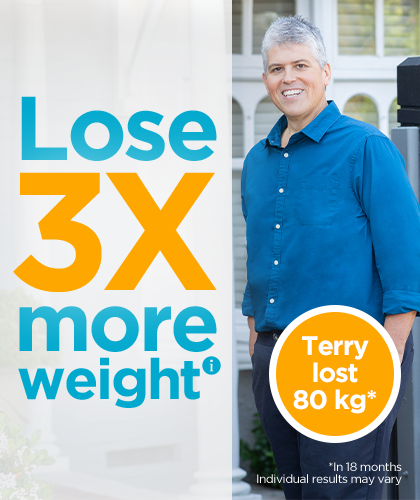Nutrition and osteoporosis: Eating well for strong bones

It’s a message that’s probably been drilled into you since childhood: drink milk for strong, healthy bones. This advice still holds true; calcium, the nutrient in milk responsible for those healthy bones, is a vital component of a healthy diet. But many of us aren’t consuming enough of it. In fact, the National Health Survey found that over half of the Australian population aged two years and older have inadequate intakes of calcium. Nearly three quarters of females (73%) and half of all males (51%) aged two years and over did not meet their calcium requirements based on their intakes from food.
What is osteoporosis?
Calcium forms the building blocks of your teeth and bones. A low amount of the mineral can lead to osteoporosis – a condition where your bones become thin, weak and highly fragile. Bones can break and fracture very easily in people with osteoporosis, leading to debilitating pain, disability and psychological distress.
Osteopenia can be a precursor to osteoporosis. This is a condition where bone density is decreased, but not low enough to qualify as osteoporosis. If osteopenia is properly treated, bone density levels could stabilise and may not lead to osteoporosis.
Osteoporosis affects approximately 1.2 million people in Australia. However, it’s likely that the true number of people living with the condition is higher; many people aren’t diagnosed until they experience a broken bone or fracture.
The condition is most common among older people as bone density naturally decreases with age. Older women are particularly susceptible as menopause accelerates the decrease in bone density.
Age, sex and family history are major risk factors for the development of osteoporosis, however nutritional deficiencies, physical inactivity, excess alcohol intake and smoking can also contribute to your risk.
Essential nutrients to help prevent osteoporosis
According to the Royal Australian College of General Practitioners (RACGP), the primary way to maintain bone strength is to ensure an adequate intake of calcium and vitamin D, and to exercise.
Calcium
Your body uses a tiny amount of calcium for heart, muscle, blood and nerve function, but the majority of it – nearly 99 percent – goes to your bones. When you don’t consume enough calcium to support these other functions, they take some from your bones, which is what leads to decreased bone density.
The amount of calcium you need changes over the course of your life. The Australian Dietary Guidelines recommend:
- 1,300 mg per day for teenagers.
- 1,000 mg per day for adults 19 to 50 years.
- 1,300 mg per day for women 51 years and over and men 71 years and over.
Ideally, you should be able to achieve the recommended intake of calcium for your age and gender through your diet. Unless your doctor recommends a supplement, food is always your first and best choice for nutrients.
Dietary sources of calcium: The best sources are dairy products (milk, yoghurt, cheese), tinned fish with tiny edible bones (sardines), calcium-fortified soy products (tofu, tempeh, fortified soy milk), and calcium-fortified cereals and breads. Legumes, dark leafy green vegetables, almonds and sesame seeds also contain some calcium.
CSIRO Total Wellbeing Diet meal plans have been designed to help you lose weight and get all the nutrients you need for optimal health and wellbeing. See how the diet can work for you.

Vitamin D
Vitamin D is just as important as calcium for bone health. Your body needs vitamin D to be able to absorb calcium. While there are some dietary sources of the vitamin, including eggs, fortified products (dairy, soy and breakfast cereals), seafood and mushrooms which have been exposed to sunlight for at least 15 minutes, it can be difficult to consume enough through food alone. The best way to get an adequate amount of vitamin D is with sun exposure.
Most people in Australia will achieve adequate sun exposure for healthy vitamin D levels by spending a few minutes outside during the day with some skin exposed. Of course, this should be balanced with sun safety, especially during summer. The Cancer Council recommends sun protection when the UV index is three or above, or when spending a lot of time outside.
However, vitamin D deficiency is prevalent in Australia, affecting one in four adults. Those at risk of deficiency include:
- Adults who spend most of their time indoors or avoid sun exposure.
- People with dark skin – UV rays don’t easily penetrate dark skin.
- People with medical conditions that impact the absorption of vitamin D.
- Pregnant or breastfeeding women.
- Elderly people.
If you’re at risk of deficiency, it’s a good idea to speak with your GP who may recommend a supplement.
While some risk factors for developing osteoporosis are out of your hands, some modifiable lifestyle factors can reduce your risk. If you’re concerned about the condition or want to learn more about treatment, talk to your GP.

How to minimise your risk of osteoporosis through lifestyle habits:
- Eat a healthy, balanced diet with an adequate intake of calcium for your age and sex.
- Ensure you get an adequate amount of vitamin D through safe sun exposure or a supplement (if recommended by your GP).
- Exercise regularly with resistance exercises and balance training.
- Minimise your alcohol consumption.
- Stop smoking.
Looking for weight loss motivation, dinner inspiration or exercise ideas? Check out the CSIRO Total Wellbeing Diet blog or take a look at some of our delicious, healthy recipes.
